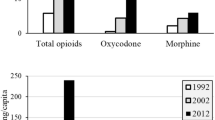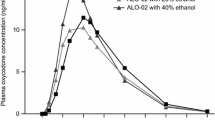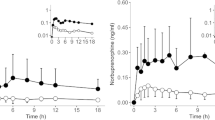Abstract
Objective
We investigated the effect of voriconazole on the pharmacokinetics and pharmacodynamics of oxycodone.
Methods
Twelve healthy subjects ingested either voriconazole or placebo for 4 days in a randomized, cross-over study. On day 3, they ingested 10 mg oxycodone. Timed plasma samples were collected for the measurement of oxycodone, noroxycodone, oxymorphone, noroxymorphone and voriconazole up to 48 h, and pharmacodynamic effects were recorded.
Results
When voriconazole was taken at the same time as oxycodone, the mean area under the plasma concentration-time curve (AUC0–∞) of oxycodone increased 3.6-fold (range 2.7- to 5.6-fold), peak plasma concentration 1.7-fold and elimination half-life 2.0-fold (p < 0.001) when compared to placebo. The AUC0-∞ ratio of noroxycodone to oxycodone was decreased by 92% (p < 0.001), and that of oxymorphone increased by 108% (p < 0.01). Pharmacodynamic effects of oxycodone were modestly increased by voriconazole.
Conclusions
Voriconazole inhibits the CYP3A-mediated N-demethylation of oxycodone, drastically increasing exposure to oral oxycodone. Clinically, lower doses of oxycodone may be needed during voriconazole treatment to avoid opioid-related adverse effects especially after repeated dosing.




Similar content being viewed by others
References
Pöyhiä R, Seppälä T, Olkkola KT, Kalso E (1992) The pharmacokinetics and metabolism of oxycodone after intramuscular and oral administration to healthy subjects. Br J Clin Pharmacol 33:617–621
Lalovic B, Phillipis B, Risler LL et al (2004) Quantitative contribution of CYP2D6 and CYP3A to oxycodone metabolism in human liver and intestinal microsomes. Drug Metab Disp 32:447–454
Lalovic B, Kharasch E, Hoffer C et al (2006) Pharmacokinetics and pharmacodynamics of oral oxycodone in healthy human subjects: role of circulating active metabolites. Clin Pharmacol Ther 79:461–479
Purkins L, Wood N, Ghahramani P et al (2002) Pharmacokinetics and safety of voriconazole following intravenous- to oral-dose escalation regimens. Antimicrob Agents Chemother 46:2546–53
Hyland R, Jones BC, Smith DA (2003) Identification of the cytochrome P450 enzymes involved in the N-oxidation of voriconazole. Drug Metab Dispos 31:540–7
Murayama N, Imai N, Nakane T et al (2008) Roles of CYP3A4 and CYP2C19 in methyl hydroxylated and N-oxidized metabolite formation from voriconazole, a new anti-fungal agent, in human liver microsomes. Biochem Pharmacol 73:2020–2026
Niwa T, Shiraga T, Takagi A (2005) Effect of antifungal drugs on cytochrome P450 (CYP) 2C9, CYP2C19, and CYP3A4 activities in human liver microsomes. Biol Pharm Bull 28:1805–1808
Niwa T, Inoue-Yamamoto S, Shigara T, Takagi A (2005) Effect of antifungal drugs on cytochrome P450 (CYP) 1A2, CYP2D6, and CYP2E1 activities in human liver microsomes. Biol Pharm Bull 28:1813–1816
Heiskanen T, Olkkola KT, Kalso E (1998) Effects of blocking CYP2D6 on the pharmacokinetics and pharmacodynamics of oxycodone. Clin Pharmacol Ther 64:603–611
Curry SC, Watts DJ, Katz KD et al (2007) The effect of single-dose tramadol on oxycodone clearance. J Emerg Med 33:407–411
Samer C, Daali Y, Rebsamen M et al (2005) Determinant role of CYP2D6 and CYP3A4 pathways on the antinociceptive effects of oxycodone. Clin Pharmacol Ther 79:P57–P57
Lee H-K, Lewis LD, Tsongalis GJ et al (2006) Negative urine screening caused by rifampicin-mediated induction of oxycodone hepatic metabolism. Clin Chim Acta 267:196–200
Michna E, Ross EL, Hynes WL et al (2004) Predicting aberrant drug behavior in patients treated for chronic pain. J Pain Symptom Manage 28:250–258
Gage R, Stopher DA (1998) A rapid HPLC assay for voriconazole in human plasma. J Pharm Biomed Anal 17:1449–1453
Pennick GJ, Clark M, Sutton DA, Rinaldi MG (2003) Development and validation of HPLC assay for voriconazole. Antimicrob Agents Chemother 7:2348–2350
Neuvonen M, Neuvonen PJ (2008) Determination of oxycodone, noroxycodone, oxymorphone and noroxymorphone in human plasma by liquid chromatography-electrospray-tandem mass spectrometry. Ther Drug Monit 30:333–430
Sistonen J (2005) CYP2D6 genotyping by a multiplex primer extension reaction. Clin Chem 51:1291–1295
Bond A, Lader M (1974) The use of analogue visual scales in rating subjective feelings. Br J Med Psychol 47:211–218
Hannington-Kiff JG (1970) Measurements of recovery from outpatient general anaesthesia with a simple ocular test. BMJ 3:132–135
Stone BM (1984) Pencil and paper tests: sensitivity to psychotropic drugs. Br J Clin Pharmacol 18:15S–20S
Cogan DG (1941) Simplified entoptic pupillometer. Am J Ophthalmol 24:1431–1433
Wolff BB, Kantor TG, Jarvik ME, Laska E (1966) Response of experimental pain to analgesic drugs. 1. Morphine, aspirin, and placebo. Clin Pharmacol Ther 7:224–38
Saari TI, Laine K, Leino K et al (2006) Effect of voriconazole on the pharmacokinetics of oral and intravenous midazolam. Clin Pharmacol Ther 79:362–370
Saari TI, Laine K, Leino K et al (2007) Effect of voriconazole on the pharmacokinetics and pharmacodynamics of zolpidem in healthy subjects. Br J Clin Pharmacol 63:116–120
Saari TI, Laine K, Bertilsson L et al (2007) Voriconazole and fluconazole increase the exposure to oral diazepam. Eur J Clin Pharmacol 63:941–949
Saari TI, Laine K, Leino K et al (2006) Voriconazole, but not terbinafine, markedly reduces alfentanil clearance and prolongs its half-life. Clin Pharmacol Ther 80:502–8
Saari TI, Laine K, Neuvonen M et al (2008) Effect of voriconazole and fluconazole on the pharmacokinetics of intravenous fentanyl. Eur J Clin Pharmacol 64:25–30
Liu P, Foster G, LaBadie R et al (2007) Pharmacokinetic interaction between voriconazole and methadone at steady state in patients on methadone therapy. Antimicrob Agents Chemother 51:110–118
Olkkola KT, Aranko K, Luurila H et al (1993) A potentially hazardous interaction between erythromycin and midazolam. Clin Pharmacol Ther 53:298–305
Olkkola KT, Ahonen J, Neuvonen PJ (1996) The effect of the systemic antimycotics, itraconazole and fluconazole, on the pharmacokinetics and pharmacodynamics of intravenous and oral midazolam. Anesth Analg 82:511–516
Ahonen J, Olkkola KT, Neuvonen PJ (1997) Effect of route of administration of fluconazole on the interaction between fluconazole and midazolam. Eur J Clin Pharmacol 51:415–419
Mihara A, Mori T, Aisa Y et al (2008) Greater impact of oral fluconazole on drug interaction with intravenous calcineurin inhibitors as compared with intravenous fluconazole. Eur J Clin Pharmacol 64:89–91
Poulsen L, Brøsen K, Arendt-Nielsen L et al (1996) Codeine and morphine in extensive and poor metabolizers of sparteine: pharmacokinetics, analgesic effect and side effects. Eur J Clin Pharmacol 51:289–295
Paar WD, Poche S, Gerloff J, Dengler HJ (1997) Polymorphic CYP2D6 mediates O-demethylation of the opioid analgesic tramadol. Eur J Clin Pharmacol 53:235–239
Eap CB, Broly F, Mino A et al (2001) Cytochrome P450 2D6 genotype and methadone steady-state concentrations. J Clin Psychopharmacol 21:229–234
Liukas A, Kuusniemi K, Aantaa R et al (2008) Plasma concentrations of oral oxycodone are greatly increased in the elderly. Clin Pharmacol Ther (epub ahead of print). doi:10.1038/clpt.2008.64
de Leon J, Dinsmore L, Wedlund P (2003) Adverse drug reactions to oxycodone and hydrocodone in CYP2D6 ultrarapid metabolizers. J Clin Psychopharm 23:420–421
Susce MT, Murray-Carmichael E, de Leon J (2006) Response to hydrocodone, codeine and oxycodone in a CYP2D6 poor metabolizer. Prog Neuropsychopharmacol Biol Psychiatry 30:1356–1358
Foster A, Mobley E, Wang Z (2007) Complicated pain management in a CYP2D6 poor metabolizer. Pain Pract 7:352–356
Koltzenburg M, Pokorny R, Gasser UE, Richarz U (2006) Differential sensitivity of three experimental pain models in detecting the analgesic effects of transdermal fentanyl and buprenorphine. Pain 126:165–174
Sarton E, Olofsen E, Romberg R et al (2000) Sex differences in morphine analgesia: an experimental study in healthy volunteers. Anesthesiol 93:1245–1254
Thompson SJ, Koszdin K, Bernards CM (2000) Opiate-induced analgesia is increased and prolonged in mice lacking P-glycoprotein. Anesthesiol 92:1392–9
Wang JS, Ruan Y, Taylor RM et al (2004) Brain penetration of methadone (R)- and (S)-enantiomers is greatly increased by P-glycoprotein deficiency in the blood-brain barrier of Abcb1a gene knockout mice. Psychopharmacology (Berl) 173:132–138
Boström E, Simonsson US, Hammarlund-Udenaes M (2005) Oxycodone pharmacokinetics and pharmacodynamics in the rat in the presence of the P-glycoprotein inhibitor PSC833. J Pharm Sci 94:1060–1066
Acknowledgements
We thank Mrs. Elina Kahra for technical assistance and Professor Antti Pertovaara for the use of the TSA-2. The study was supported by the EVO grant 13821 of the Hospital District of Southwest Finland. All experiments comply with the current laws in Finland, where the research was performed. There are no conflicts of interest.
Author information
Authors and Affiliations
Corresponding author
Rights and permissions
About this article
Cite this article
Hagelberg, N.M., Nieminen, T.H., Saari, T.I. et al. Voriconazole drastically increases exposure to oral oxycodone. Eur J Clin Pharmacol 65, 263–271 (2009). https://doi.org/10.1007/s00228-008-0568-5
Received:
Accepted:
Published:
Issue Date:
DOI: https://doi.org/10.1007/s00228-008-0568-5




